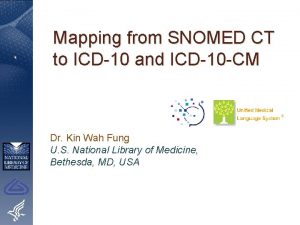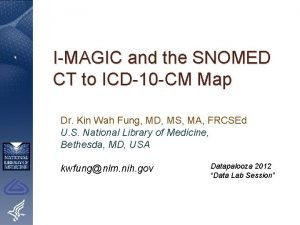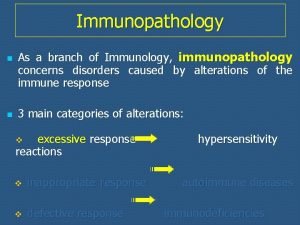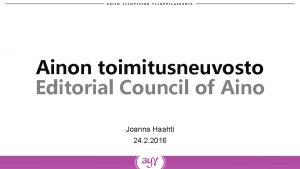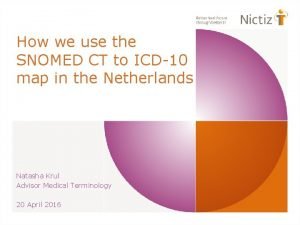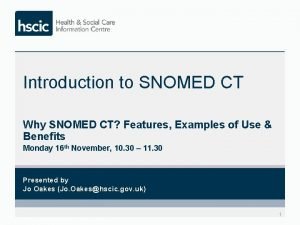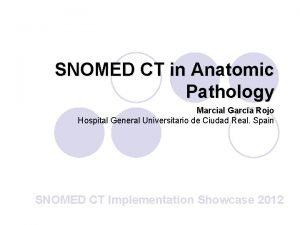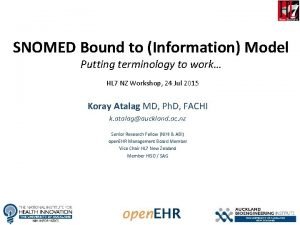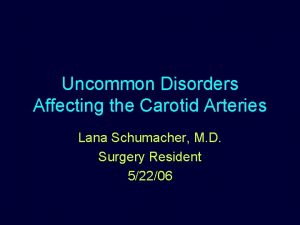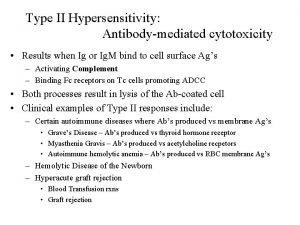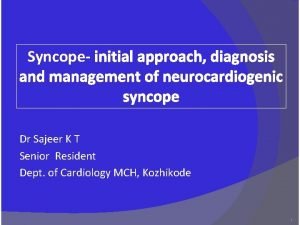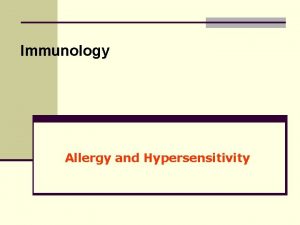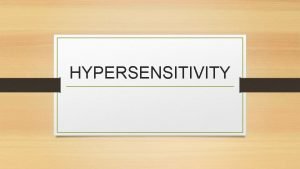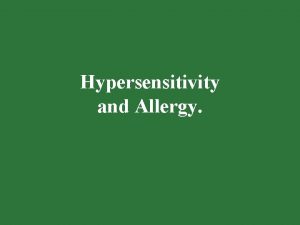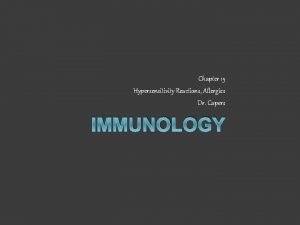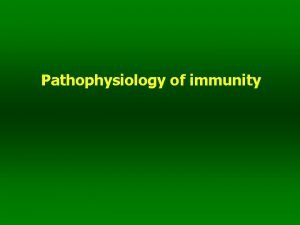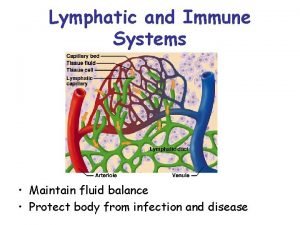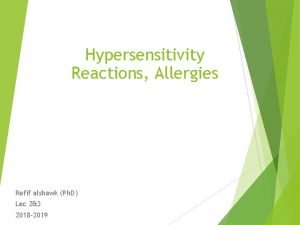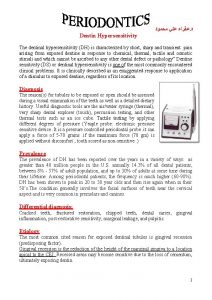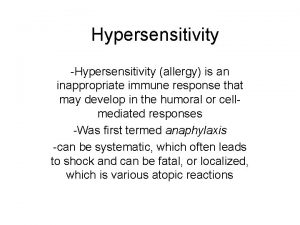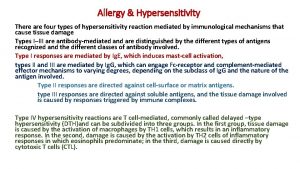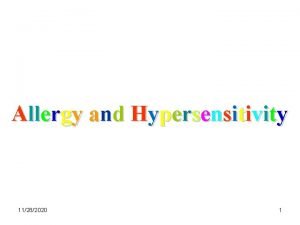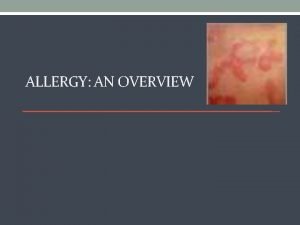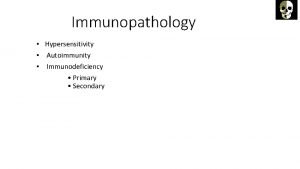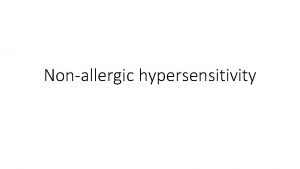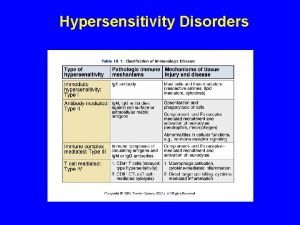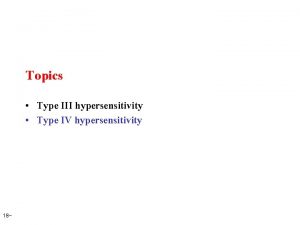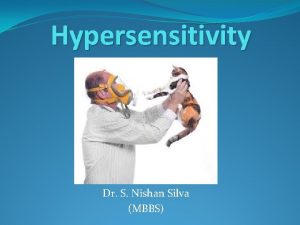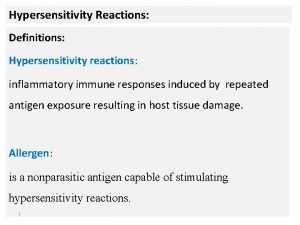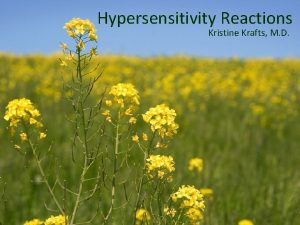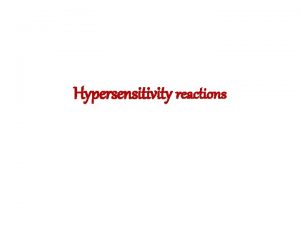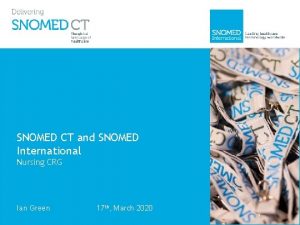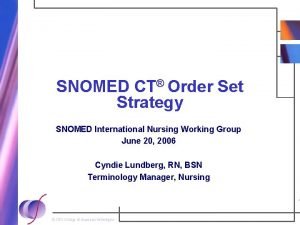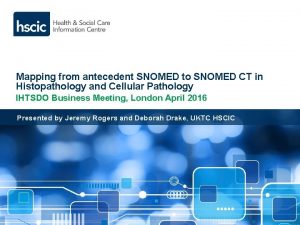Representation of Hypersensitivity and Allergy in SNOMED CT
























- Slides: 24

Representation of Hypersensitivity and Allergy in SNOMED CT Bruce J. Goldberg, MD, Ph. D

Hypersensitivity/allergy model • Hypersensitivity/allergy model is based on SDP (Structure, Disposition, Process) approach

Allergies represented by: • Dispositions (propensities): – Allergy to x • Processes (reactions) – Allergic reaction to x • Conditions (may be either propensities or reactions) – Allergic rhinitis due to x

Overall organization of allergy content in SNOMED CT • Hypersensitivity condition – Allergic condition • Allergic disposition • Allergic reaction – Hypersensitivity disposition – Hypersensitivity reaction – Pseudoallergic condition • Pseudoallergic disposition • Pseudoallergic reaction

Hypersensitivity condition • Subsumes both allergic and pseudoallergic condition and thus can capture conditions that are either truly allergic, pseudoallergic or both 1 • Important as cross reactivity related to structural classes for allergic conditions and to functional classes for pseudoallergic conditions – Example Ibuprofen Type of condition Reacts to Allergy Only ibuprofen Pseudoallergy All NSAIDs 1 As an additional measure, all pseudoallergy to x terms contain an additional description of allergy to x

“Aspirational” model for representation of allergy in SNOMED CT

Revised “aspirational” model with clinical situation (patient life phase) interpretation

Aspirational (formal ontologic) model of Allergy

Bio. Top relations used in “aspirational” allergy model Bio. Top Relation (object property) Definition Domains Ranges has. Agent A participant of a process, with the additional condition that the component instance is causally active in the relevant process. Processual entity has. Outcome participant which either - a) comes into being during the process or - b) undergoes some change during the process and constitutes (one of) the main result(s) of the process Processual entity outcome. Of Inverse of has. Outcome has. Realization inverse of realization. Of Disposition or Quality or Role Processual. Entity realization. Of Something that occurs can be the realization of a function, a disposition, or a role Processual entity Disposition or Quality or Role has. Locus relates a place with an entity which occurs, inheres, or is part of it Disposition or Immaterial. Nonphysical. Entity or Immaterial. Physical. Entity or Material. Entity or Processual. Entity or Quality or Role or Spatial. Region Immaterial. Physical. Entity or Material. Entity or Spatial. Region bearer. Of Inverse relation of inheres. In. Relates an independent continuant to a dependent one (e. g. quality, state, function, or disposition) Immaterial. Physical. Entity or Material. Entity or Spatial. Region Disposition or Function or Immaterial. Nonphysical. Entity or Quality or Role Processual entity

Changes to original model - Stefan – new btl 2 (Bio. Top. Lite) namings of some relations – for all classes distinguished between “general” and “related to Allergen X” – added situation concepts

Changes to original model – details I • has. Locus: in btl 2 „is included in“ (renamed for better understandability) • Allergen-specific IGE: is not always included in an immune system structure, because it can be isolated from it: therefore, btl 2 compatible: 'at some time' some ('is included in' some Immune. System. Structure) • Allergen-specific Ig. E is related to “X”, therefore introduction of subclass Allergen. Xspecific IGE • Allergic reaction and Allergic disorder: If you mean that for every Allergic reaction there is some Allergic Disorder as an outcome and vice versa, then there should be used the quantifier “some”

Changes to original model – details II • Allergic reaction / allergic sensitization: Subclasses introduced: Allergic reaction to X / allergic sensitization to X (in order to distinguish the general classes from the specific ones) • Sensitization: has outcome “some” (not “only”) – because there is always some Ig. E as outcome (and I would not exclude that there is any other outcome) • Allergic disposition. Allergy. To. X: I added the definitional condition “Allergic. Disposition. Allergy and 'has realization' only Allergic. Reaction. To. X” This cannot be expressed by the current SNOMED CT syntax, which explains the additional relation with “has. Agent. Of. Realization”

Features of current implemented model for allergic conditions in SNOMED CT • Top level terms fully defined by means of pathological process role using the following role values • Hypersensitivity process (qualifier value) – Allergic process (qualifier value) » Allergic sensitization process(qualifier value) – Pseudoallergic process (qualifier value)

Features of currently implemented model for allergic conditions in SNOMED CT II • Novel approach taken to linking a causative agent to the allergy disposition for purposes of data retrieval – Causative agents cause the realization of the disposition (the allergic reaction process) and not the disposition itself (the allergic disposition) – Causative agent linked to the process of allergic sensitization which necessarily precedes an allergic disposition by use of the following role group: • Group {|after|=|allergic sensitization| |causative agent|=|x substance|

Definitions-Hypersensitivity Term Current definition Hypersensitivity condition The disposition to develop an allergic or pseudoallergic reaction, the reaction itself or its consequences. Hypersensitivity disposition The disposition to develop an allergic or pseudoallergic reaction Hypersensitivity reaction A pathological process initiated by exposure to a defined stimulus at a dose tolerated by normal persons. It is the realization of the disposition to hypersensitivity.

Definitions-Allergy Term Current definition Allergic condition The disposition to develop an allergic reaction, the allergic reaction itself or its consequences Allergic disposition The disposition to develop an allergic reaction A pathological immune process generally directed towards a foreign antigen, which results in tissue injury, which is usually transient. It is the realization of the allergic disposition. It is most often applied to type I hypersensitivity but other hypersensitivity types especially type IV (e. g. allergic contact dermatitis) may be involved

Definitions-Allergic sensitization Term Current definition Allergic sensitization A process characterized by a humoral or cell-mediated immune response to a foreign antigen resulting in the production of specific antibodies and/or immune cells which may then lead to an allergic disposition.

Definitions-Pseudoallergy Term Current definition Pseudoallergic condition The disposition to develop a pseudoallergic reaction, the pseudoallergic reaction itself or its consequences Pseudoallergic disposition The disposition to develop a pseudoallergic reaction Pseudoallergic reaction A pathological nonimmune process generally directed towards a foreign substance, which results in tissue injury, which is usually transient. It is the realization of the pseudoallergic disposition. A variety of mechanisms such as direct histamine release, complement activation, cyclooxygenase activation and bradykinin generation may be involved

Agents that can act as allergens or pseudoallergens • There are some substances that may be able to elicit allergic as well as pseudoallergic reactions • Examples Include NSAIDs, protamine and perhaps radiocontrast agents and opiates

NSAID hypersensitivity I • A classification scheme for NSAID hypersensitivity taking into account allergy and pseudoallergy has been developed • NSAID pseudo allergy – Type 1: NSAID-induced asthma and rhinosinusitis – Type 2: NSAID-induced urticaria/angioedema in patients with chronic urticaria – Type 3: NSAID-induced urticaria/angioedema in otherwise asymptomatic individuals – - Type 4: Blended reactions in otherwise asymptomatic individuals • NSAID allergy – Type 5: Urticaria/angioedema to a single NSAID - urticaria and/or angioedema within minutes to one hour of taking a particular NSAID or ASA. These patients generally do not have underlying chronic urticaria. – Type 6: Anaphylaxis to a single NSAID (not ASA) Type 6 reactions are distinguished from type 5 reactions based only upon severity. Typical symptoms of anaphylaxis include shortness of breath/wheezing due to bronchospasm or laryngeal edema and hypotension due to vascular collapse.

Review of allergy use cases I • Use case 1 – Representation of Allergy to X i. e the disposition to developing an allergic reaction after exposure to allergen X – Fit with IHTSDO strategy » 1 B Problem list diagnosis » 1 D Allergy list » 2 A Medication / allergy management • Use case 2 – Representation of specific allergic/immunologic disorders such as allergic rhinits – Fit with IHTSDO strategy » 1 B Problem list Diagnosis • There are 29 diagnoses on the SNOMED CT core problem list that refer to allergy, anaphylaxis or hypersensitivity. Allergic rhinitis is the top 11 th diagnosis. » 2 A Medication / allergy management » Relevant for decision support algorithms involving medication management in allergic individuals. An example would be an alert regarding use of radiocontrast agents in those with a history of an atopic disorder.

Review of allergy use cases II • Use case 3 – Representation of specific allergic disorders caused by allergen X e. g. Allergic rhinitis due to pollen – Fit with IHTSDO strategy » 1 B Problem list diagnosis » 1 D Allergy list » 2 A Medication / allergy management • Use Case 4 – Representation of Non-specified allergic reactions to allergen X such as allergic reaction to penicillin – Fit with IHTSDO strategy » 1 B Problem list diagnosis » There is a need to distinguish an episode of an allergic reaction to a particular substance occurring at the time of an encounter from a disposition to an allergic reaction to a particular substance

Review of allergy use cases III • Use Case 5 – Representation of specific types of allergic reactions to allergen x such as anaphylactic reaction to penicillin – Fit with IHTSDO strategy » 1 B Problem list diagnosis

Allergic disposition vs. History of allergy • History of x allergy may be interpreted as an allergy that has resolved or is in remission but more likely as allergy to x (the disposition) which is not currently manifest due to lack of exposure to the relevant allergen • For this reason all history of x allergy concepts in SNOMED CT have been retired for the Jan. 2015 release pointing to the corresponding allergy to x term • For those rare cases in which an allergy has resolved such as childhood egg, milk or peanut allergy, the documentation of allergy can just be removed from the record. • The clinical requirement for documenting an allergy that is no longer present is unclear as it may lead to unnecessary avoidance. • Patient reported histories of drug allergies are often innacurate 1 1 Health care use and serious infection prevalence associated with penicillin “allergy” in hospitalized patients: A cohort study, Macy, Eric et al. Journal of Allergy and Clinical Immunology , Volume 133 , Issue 3 , 790 - 796
 Snomed ct and icd 10
Snomed ct and icd 10 Snomed to icd 10
Snomed to icd 10 Anaphylaxis images
Anaphylaxis images Joanna haahti
Joanna haahti Icd 10 to snomed
Icd 10 to snomed Soe snomed
Soe snomed Benign rolandic epilepsy icd 10
Benign rolandic epilepsy icd 10 Snomed codes pathology
Snomed codes pathology Terminology
Terminology Snomedct
Snomedct Loinc snomed
Loinc snomed Carotid sinus hypersensitivity
Carotid sinus hypersensitivity Type 2 hypersensitivity
Type 2 hypersensitivity Chess score syncope
Chess score syncope Eosinphillic
Eosinphillic Enduring pattern meaning
Enduring pattern meaning Serum sickness hypersensitivity type
Serum sickness hypersensitivity type Schultz-dale phenomenon is which type of hypersensitivity
Schultz-dale phenomenon is which type of hypersensitivity Hypersensitivity
Hypersensitivity Capers allergy
Capers allergy Dermatomyositis hypersensitivity type
Dermatomyositis hypersensitivity type Type 2 hypersensitivity
Type 2 hypersensitivity Types of allergic reactions
Types of allergic reactions Gingivoplasty
Gingivoplasty Dental hypersensitivity
Dental hypersensitivity
